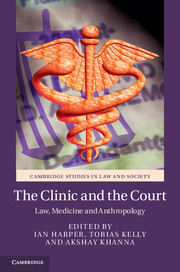Book contents
- The Clinic and the Court
- Cambridge Studies in Law and Society
- The Clinic and the Court
- Copyright page
- Contents
- Contributing Authors
- Book part
- Introduction
- Part One Recognising harm and suffering
- Chapter One Keeping magical harm invisible: Public health, witchcraft and the law inKyela, Tanzania
- Chapter Two Non-humansuffering: A humanitarian project
- ChapterThree The causes of torture: Law, medicine and the assessment of suffering in British asylum claims
- Chapter Four Trespass, crime and insanity: the social life of categories
- Chapter Five Local justice in the allocation of medicalcertificates during French asylum procedures: From protocols to face-to-face interactions
- Chapter Six Contentious Roommates? Spatial constructions of the therapeutic-evidential spectrum inmedicolegal work
- Part Two Understanding and allocating remedy
- Index
- Series page
- References
Chapter Two - Non-humansuffering: A humanitarian project
from Part One - Recognising harm and suffering
Published online by Cambridge University Press: 05 May 2015
- The Clinic and the Court
- Cambridge Studies in Law and Society
- The Clinic and the Court
- Copyright page
- Contents
- Contributing Authors
- Book part
- Introduction
- Part One Recognising harm and suffering
- Chapter One Keeping magical harm invisible: Public health, witchcraft and the law inKyela, Tanzania
- Chapter Two Non-humansuffering: A humanitarian project
- ChapterThree The causes of torture: Law, medicine and the assessment of suffering in British asylum claims
- Chapter Four Trespass, crime and insanity: the social life of categories
- Chapter Five Local justice in the allocation of medicalcertificates during French asylum procedures: From protocols to face-to-face interactions
- Chapter Six Contentious Roommates? Spatial constructions of the therapeutic-evidential spectrum inmedicolegal work
- Part Two Understanding and allocating remedy
- Index
- Series page
- References
- Type
- Chapter
- Information
- The Clinic and the CourtLaw, Medicine and Anthropology, pp. 49 - 71Publisher: Cambridge University PressPrint publication year: 2015
References
- 15
- Cited by

